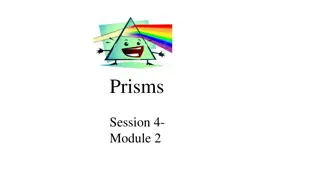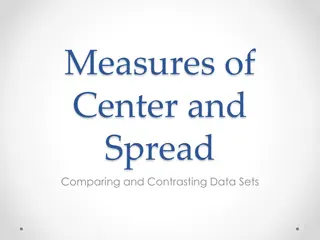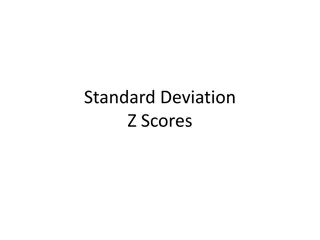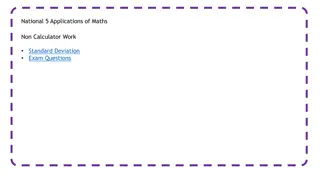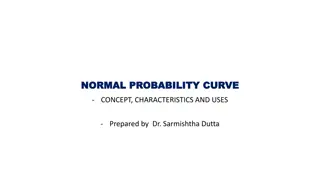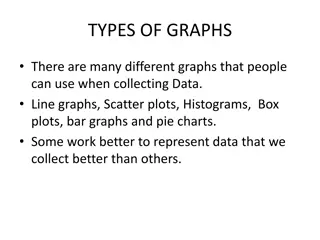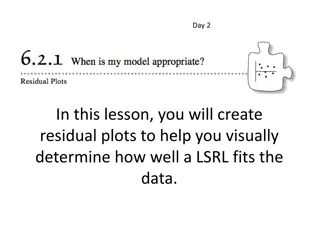Learning Dot Plots and Mean Absolute Deviation
In this lesson, students will explore dot plots and measure variation with mean absolute deviation. They will learn to calculate the mean arm span length using a set of data and understand the characteristics impacting the mean absolute deviation. Essential questions guide the learning process, reinforcing understanding of the MAD concept. Practical problems like determining the mean arm span from student measurements engage students in applying mathematical concepts to real-world scenarios. Through warm-up activities and problem-solving tasks, students enhance their skills in interpreting data and deriving meaningful insights.
Download Presentation

Please find below an Image/Link to download the presentation.
The content on the website is provided AS IS for your information and personal use only. It may not be sold, licensed, or shared on other websites without obtaining consent from the author.If you encounter any issues during the download, it is possible that the publisher has removed the file from their server.
You are allowed to download the files provided on this website for personal or commercial use, subject to the condition that they are used lawfully. All files are the property of their respective owners.
The content on the website is provided AS IS for your information and personal use only. It may not be sold, licensed, or shared on other websites without obtaining consent from the author.
E N D
Presentation Transcript
Lesson Dot Plots and Measure of Variation with Mean Absolute Deviation
[OBJECTIVE] The student will use dot plots and data sets to determine mean absolute deviation.
[MYSKILLS] Dot plots Variability Absolute Value Mean Median Center
[ESSENTIALQUESTIONS] 1. What is the MAD (mean absolute deviation)? 2. How can I use the mean to help determine the MAD of a set of data? 3. What characteristics of a data set impact the MAD?
[Warm-Up] Begin by completing the warm-up for this lesson
SOLVE Problem MEASURE OF CENTER - MEAN
SOLVE Mr. Tomas is working with his math class on collecting data. He asks students to measure the arm span of their partner and record it in their math notebook for the project. The arm spans of seven of the students are listed below. What is the mean arm span length? Arm span of seven students in inches: 60, 54, 48, 51, 59, 57, 56 S Study the Problem Underline the question. This problem is asking me to find the mean of the length of the arm spans.
SOLVE Mr. Tomas is working with his math class on collecting data. He asks students to measure the arm span of their partner and record it in their math notebook for the project. The arm spans of seven of the students are listed below. What is the mean arm span length? Arm span of seven students in inches: 60, 54, 48, 51, 59, 57, 56 O Organize the Facts Identify the facts. Eliminate the unnecessary facts. List the necessary facts. Arm spans in inches: 60, 54, 48, 51, 59, 57, 56
L Line Up a Plan Write in words what your plan of action will be. Find the sum of the arm spans and then divide by the number of data values. Choose an operation or operations. Addition, Division
V Verify Your Plan with Action Estimate your answer. About 50 inches Carry out your plan. 60 + 54 + 48 + 51 + 59 + 57 + 56 = 385 385 7 = 55 inches
E Examine Your Results Does your answer make sense? (compare your answer to question.) Yes, because I was looking for the mean of the measure of the arm span of the students. Is your answer reasonable? (compare your answer to the estimate.) Yes, because it is close to my estimate of about 50 inches.
Is your answer accurate? (check your work.) Yes. Write your answer in a complete sentence. The length of the mean arm span is 55 inches.
Discovery Activity EXTEND THE SOLVE PROBLEM DETERMINING THE DEVIATION FROM THE MEAN
Discovery Activity Extend the SOLVE Problem Determining the Deviation from the Mean What type of measure were we finding when we found the mean in the SOLVE problem? measure of center
Discovery Activity Extend the SOLVE Problem Determining the Deviation from the Mean What is a measure of center? A measure of center is numerical data described in a single value. Can you name another measure of center that we use? Median
Discovery Activity Extend the SOLVE Problem Determining the Deviation from the Mean When working with box plots we found the IQR. What is the IQR a measure of? Variability What does the IQR describe? It describes the variability in the middle 50% of the data.
Discovery Activity Extend the SOLVE Problem Determining the Deviation from the Mean What is measure of variability? Measure of variability describes how the values vary when compared to a single number. With your partner, discuss ways that you can use the mean.
Discovery Activity Extend the SOLVE Problem Determining the Deviation from the Mean 49 50 51 52 53 54 55 56 57 58 60 48 59 What type of graph is shown? A number line
Discovery Activity Extend the SOLVE Problem Determining the Deviation from the Mean 49 50 51 52 53 54 55 56 57 58 60 48 59 What is the lowest value on the number line? 48 What is the greatest value on the number line? 60
Discovery Activity Extend the SOLVE Problem Determining the Deviation from the Mean 49 50 51 52 53 54 55 56 57 58 60 48 59 Place a dot to represent each data value from the SOLVE problem. What is the mean of the data set? 55 Mark the mean on the number line with a star.
Discovery Activity Extend the SOLVE Problem Determining the Deviation from the Mean Data Value Number of inches from Mean Left or Right Positive or negative Deviation from Mean Absolute Deviation 48 51 54 56 57 59 60 Let s start by listing all of the data values marked on the number line.
Discovery Activity Extend the SOLVE Problem Determining the Deviation from the Mean Identify the placement of the lowest value on the number line. 48 Discuss ways that you can determine the distance from the mean of 55 to the lowest value of 48 using the number line.
Discovery Activity Extend the SOLVE Problem Determining the Deviation from the Mean 49 50 51 52 53 54 55 56 57 58 60 48 59 How can we find the distance from the mean to the least value, using the number line? Since the values in the number line use a scale of 1, we can start at 55 and mark each space moved until we reach 48.
Discovery Activity Extend the SOLVE Problem Determining the Deviation from the Mean 49 50 51 52 53 54 55 56 57 58 60 48 59 How many spaces do we need to move? 7
Discovery Activity Extend the SOLVE Problem Determining the Deviation from the Mean Data Value Number of inches from Mean Left or Right Positive or negative Deviation from Mean Absolute Deviation 7 Left 48 51 54 56 57 59 60 Did we move to the right or the left on the number line?
Discovery Activity Extend the SOLVE Problem Determining the Deviation from the Mean 49 50 51 52 53 54 55 56 57 58 60 48 59 What does it mean when we move to the left on the number line? It is a move in the negative direction.
Discovery Activity Extend the SOLVE Problem Determining the Deviation from the Mean Data Value Number of inches from Mean 7 Left or Right Positive or negative Negative Deviation from Mean Absolute Deviation Left 48 51 54 56 57 59 60 We moved to the left, therefore, this was a negative move.
Discovery Activity Extend the SOLVE Problem Determining the Deviation from the Mean Data Value Number of inches from Mean Left or Right Positive or negative Deviation from Mean Absolute Deviation -7 7 Left Negative 48 51 54 56 57 59 60 How can we model that move using an integer?
Discovery Activity Extend the SOLVE Problem Determining the Deviation from the Mean Data Value Number of inches from Mean Left or Right Positive or negative Deviation from Mean Absolute Deviation -7 7 Left Negative 48 51 54 56 57 59 60 This is called the deviation from the mean.
Discovery Activity Extend the SOLVE Problem Determining the Deviation from the Mean 49 50 51 52 53 54 55 56 57 58 60 48 59 What is Deviation from the Mean? Deviation is how the data value is different from the mean. Can a distance ever be a negative number? No. For example, you cannot walk a negative 7 steps.
Discovery Activity Extend the SOLVE Problem Determining the Deviation from the Mean 49 50 51 52 53 54 55 56 57 58 60 48 59 What is Absolute Value? The distance a number is from zero on a number line. What do you think that means for absolute deviation? Absolute deviation must be a positive value.
Discovery Activity Extend the SOLVE Problem Determining the Deviation from the Mean 49 50 51 52 53 54 55 56 57 58 60 48 59 What is the absolute deviation for 48? 7
Discovery Activity Extend the SOLVE Problem Determining the Deviation from the Mean Data Value Number of inches from Mean Left or Right Positive or negative Deviation from Mean Absolute Deviation -7 7 Left Negative 7 48 51 54 56 57 59 60 The absolute deviation of 48 is 7.
Discovery Activity Extend the SOLVE Problem Determining the Deviation from the Mean 49 50 51 52 53 54 55 56 57 58 60 48 59 What is the next value on the number line? 51 How can we find the distance from the mean to 51? Since the values in the number line use a scale of 1, we can start at 55 and mark each space moved until we reach 51.
Discovery Activity Extend the SOLVE Problem Determining the Deviation from the Mean 49 50 51 52 53 54 55 56 57 58 60 48 59 How many spaces do we need to move? 4 Did we move to the right or to the left? We moved to the left which means it was a negative move.
Discovery Activity Extend the SOLVE Problem Determining the Deviation from the Mean Data Value Number of inches from Mean Left or Right Positive or negative Deviation from Mean Absolute Deviation -7 7 4 Left Left Negative Negative 7 48 51 54 56 57 59 60 Move 4 inches to left (negative).
Discovery Activity Extend the SOLVE Problem Determining the Deviation from the Mean 49 50 51 52 53 54 55 56 57 58 60 48 59 What is the deviation from the mean? 4 Can a distance ever be a negative number? No. You cannot walk a negative 4 steps.
Discovery Activity Extend the SOLVE Problem Determining the Deviation from the Mean 49 50 51 52 53 54 55 56 57 58 60 48 59 What do you think that means for the absolute deviation? It must be a positive value. What is the absolute deviation for 51? 4
Discovery Activity Extend the SOLVE Problem Determining the Deviation from the Mean Data Value Number of inches from Mean Left or Right Positive or negative Deviation from Mean Absolute Deviation -7 -4 7 4 Left Left Negative Negative 7 4 48 51 54 56 57 59 60 Complete the graphic organizer.
Discovery Activity Extend the SOLVE Problem Determining the Deviation from the Mean Data Value Number of inches from Mean 7 4 1 1 2 4 5 Left or Right Positive or negative Negative Negative Negative Positive Positive Positive Positive Deviation from Mean Absolute Deviation -7 -4 -1 1 2 4 5 Left Left Left Right Right Right Right 7 4 1 1 2 4 5 48 51 54 56 57 59 60 Total of absolute deviation values MAD (mean absolute deviation)
Discovery Activity EXTEND THE SOLVE PROBLEM DETERMINING THE MEAN ABSOLUTE DEVIATION
Discovery Activity Extend the SOLVE Problem Determining the Mean Absolute Deviation What is the total of the absolute deviation values? Add all seven numbers: 7 + 4 + 1 + 1 + 2 + 4 + 5 = 24 How do we determine the mean of the absolute deviation values? Find the sum and divide by the number of values. 24 7 = 3.43 rounded to the nearest hundredth
Discovery Activity Extend the SOLVE Problem Determining the Mean Absolute Deviation Data Value Number of inches from Mean 7 4 1 1 2 4 5 Left or Right Positive or negative Negative Negative Negative Positive Positive Positive Positive Deviation from Mean Absolute Deviation -7 -4 -1 1 2 4 5 Left Left Left Right Right Right Right 7 4 1 1 2 4 5 48 51 54 56 57 59 60 24 Total of absolute deviation values MAD (mean absolute deviation) 3.43
Discovery Activity Extend the SOLVE Problem Determining the Mean Absolute Deviation The MAD (mean absolute deviation) for the data set is 3.43. This means that on average, the arm span of the students varies 3.43 inches from the mean of 55 inches.
Discovery Activity Extend the SOLVE Problem Determining the Mean Absolute Deviation What does the mean show us? The mean gives the measure of center of the data set with a single number. What does the MAD show us? The mean absolute deviation describes how the data values vary from the mean with a single number.
SOLVE DETERMINING THE MEAN ABSOLUTE DEVIATION
SOLVE During the math unit on measurement, Mr. Tomas also had students collect information about foot length. The foot lengths of the eight students are listed below. Foot length of eight students in inches: 1 1 1 12 ,13 ,14 ,14,15,12,11 ,11 2 2 2 1 2 What are the mean and the MAD of the data set for the foot length of the eight students? Explain what each value means for the data set. S Study the Problem Underline the question. This problem is asking me to find the mean and MAD of the foot lengths of the eight students and explain what each term means for the data set.
During the math unit on measurement, Mr. Tomas also had students collect information about foot length. The foot lengths of the eight students are listed below. Foot length of eight students in inches: 1 1 1 12 ,13 ,14 ,14,15,12,11 ,11 2 2 2 1 2 What are the mean and the MAD of the data set for the foot length of the eight students? Explain what each value means for the data set. O Organize the Facts Identify the facts. Eliminate the unnecessary facts. List the necessary facts. Foot length of eight students in inches: 1 2 1 2 1 2 1 2 12 ,13 ,14 ,14,15,12,11 ,11
L Line Up a Plan Write in words what your plan of action will be. Mean: Find the sum of the values and then divide by the number of values to determine the mean. Choose an operation or operations. Mean: addition, division
L Line Up a Plan Write in words what your plan of action will be. MAD: Put the scores in order from least to greatest. Place the values on a number line. Mark the mean on the number line. Count the number of spaces from each value to the mean and chart the absolute deviation for each. Find the total of the values for absolute deviation and divide by the number of values in that column to determine the MAD. Choose an operation or operations. MAD: addition, division


